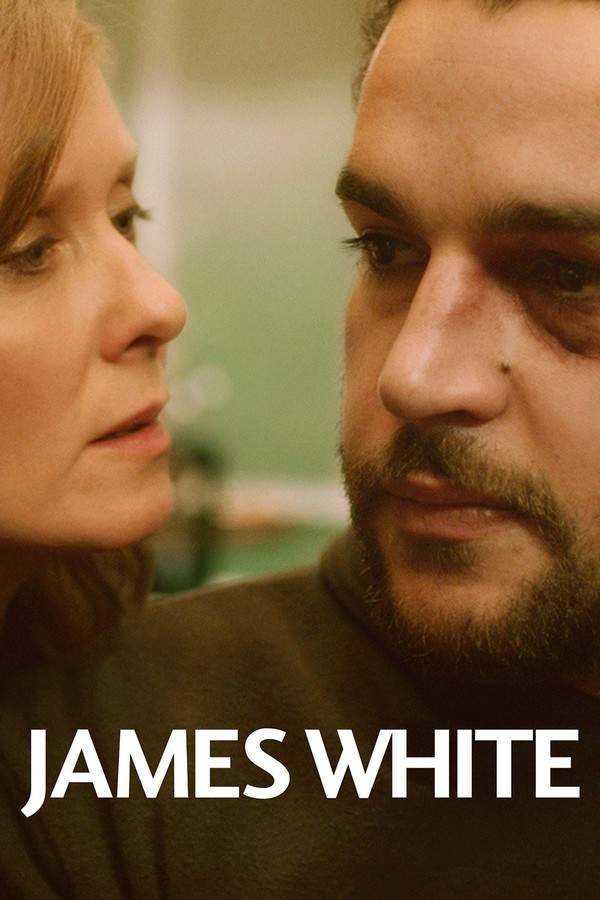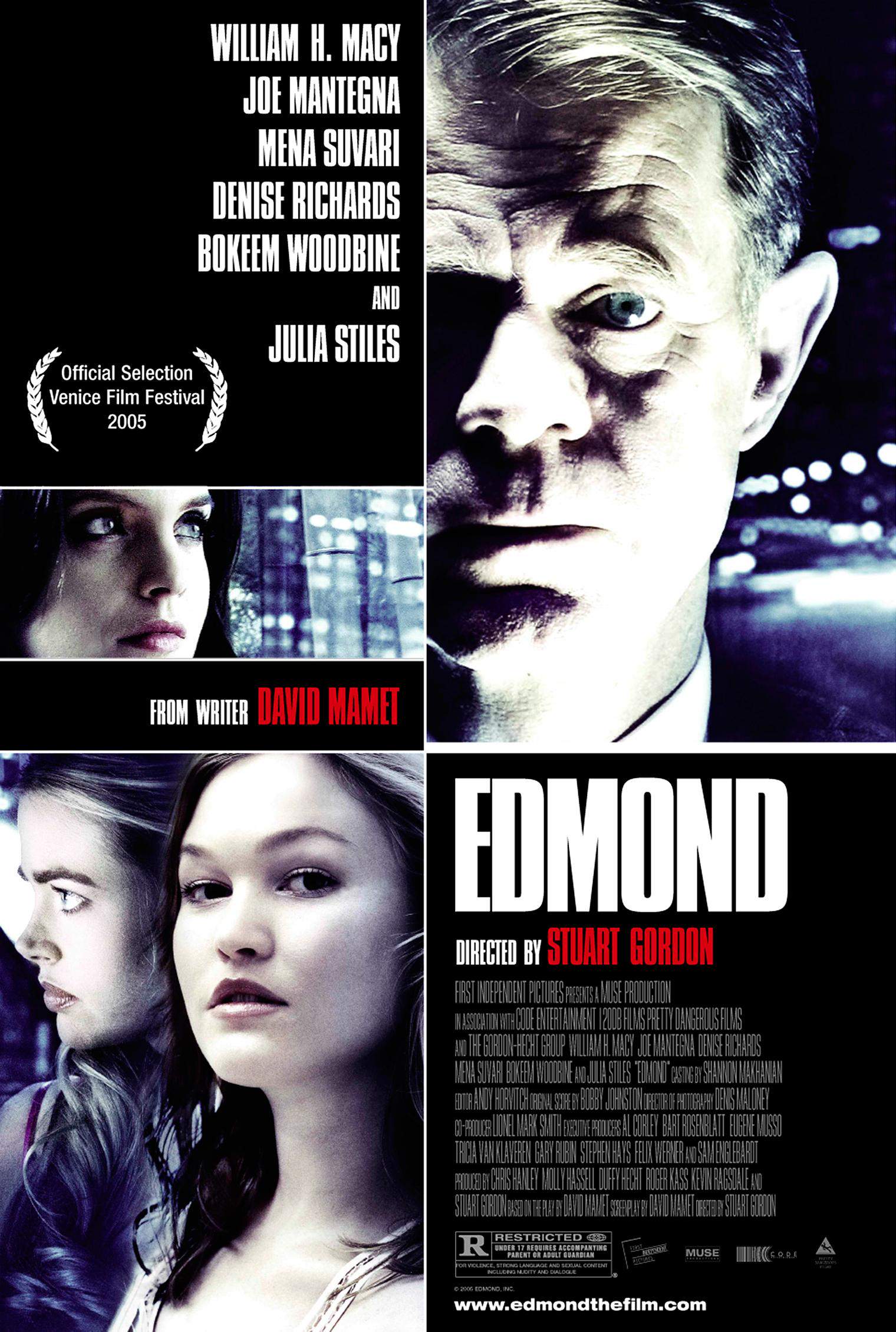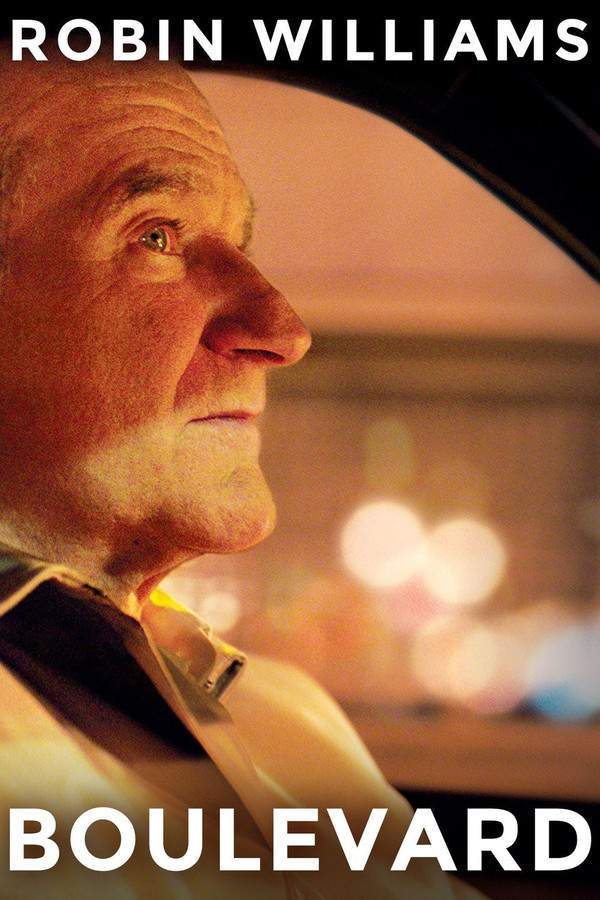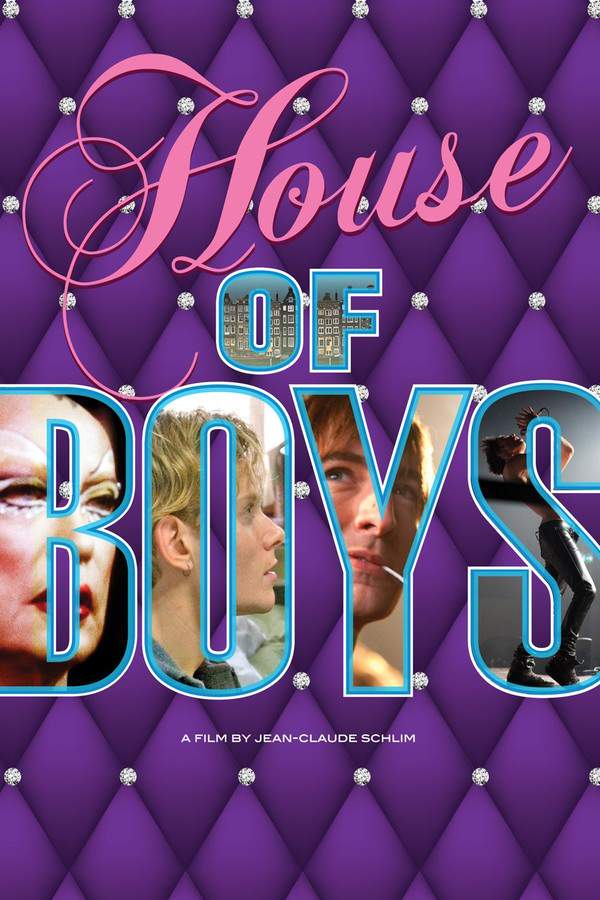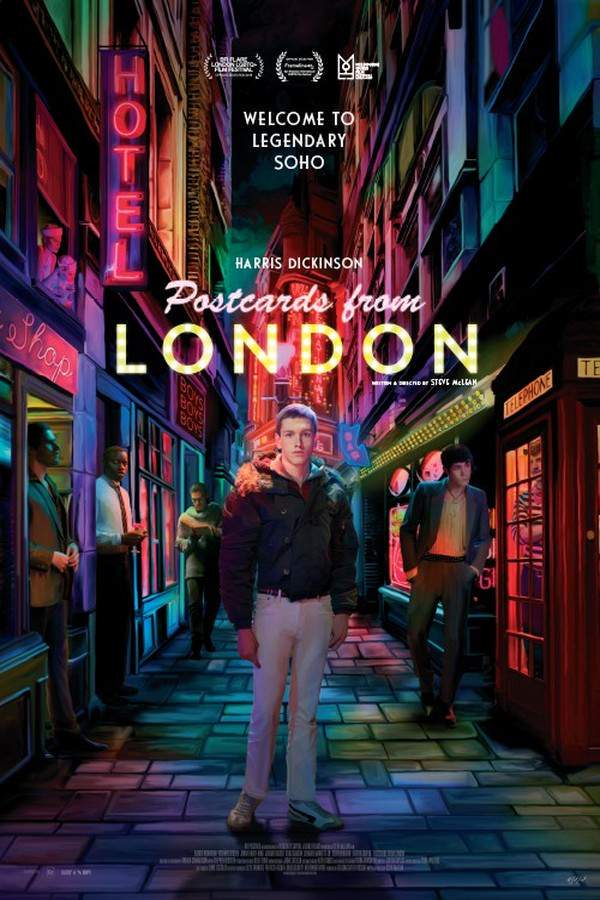
Postcards from London 2018
Directed by

Steve McLean
Made by

Strand Releasing
Test your knowledge of Postcards from London with our quiz!
Postcards from London Plot Summary
Read the complete plot summary and ending explained for Postcards from London (2018). From turning points to emotional moments, uncover what really happened and why it matters.
As the National Gallery’s 16th-century masterpiece by Titian commands attention, Jim, embodying small-town innocence, finds himself irresistibly drawn to its artistic allure. Losing consciousness in awe of the painting, this incident catapults him into a journey of self-discovery through the vibrant streets of SoHo. Here, he encounters a compassionate barmaid who affectionately calls him an “angel-faced innocent,” and a group of intriguing characters, including David, Jesus, Marcello, and Victor, who introduce him to their unconventional world of entertaining wealthy patrons as raconteurs.
As Jim dives headfirst into this new life, his immersion in the cultural arts escalates, influenced significantly by the evocative paintings of Caravaggio. His experiences go beyond art appreciation; he becomes entwined in the complexities of the sex trade, even establishing his own viewing booth. Among his eclectic patrons is an author who shares his reverence for Caravaggio’s artistry. During a pivotal encounter, Jim is magically transported into a canvas, playing the role of Christ while the client provides sage advice: > “Enjoy your youth.”
The sensitivity of Jim becomes even more evident as he takes on the fantasy of an old gentleman, reenacting scenes from Ancient Rome as Saint Sebastian. Overwhelmed by guilt, he refunds the fee, yet soon his allure as a muse spreads throughout SoHo. Noticing his unique charisma, Max, an artist in search of inspiration, invites Jim to model for him. After several months, Jim’s presence revitalizes Max’s career, resulting in an extraordinary piece of art.
However, as Jim’s fame rises, so do concerns over his frequent fainting. David and the group encourage him to seek a doctor’s advice, leading to a diagnosis of Stendhal Syndrome—a condition that envelops him in artistic euphoria. This phenomenon is vividly illustrated when the doctor presents The Musicians by Caravaggio, causing another trance inducing fainting episode. Transported back to 1595 Rome, Jim finds himself in the company of his friends as they spring to life from the painting. Caravaggio himself tenderly rebukes their idle chatter, connecting with Jim in a profound manner before vanishing into his work. Awakening from this reverie, Jim speaks with an intimate understanding of the artist, demonstrating the transformative power of art.
As Jim continues to oscillate between consciousness and artistic dreams, he morphs into different personas, becoming intertwined with the presence of Max. In a reflective exchange with a perceptive client, Jim contemplates his heightened sensitivity to art—an awareness fractured by the sudden arrival of Paul, a figure from his past cloaked in bitterness over their shared history in the same clandestine profession.
Paul’s revelations prompt Jim to contemplate the monetization of his emotional responses to art. With a proposal to harness Jim’s empathetic abilities to discern genuine art from the counterfeit, Paul tantalizingly suggests they could secure significant rewards. Their fateful meeting culminates in a burgeoning connection enriched with the potential of opportunity.
Days unfold with Paul orchestrating tests to exploit Jim’s exceptional talent, but internal conflicts arise as Jim grapples with a sense of shame tied to his gift. Once united in camaraderie, Jim’s loyal companions now harbor feelings of betrayal towards him.
Amidst a backdrop of aspirations, newcomers jump at the chance to profit from Jim’s growing reputation in the art world. Meanwhile, Paul and the doctor champion Jim’s unusual abilities as valuable services deserving of financial reward. Yet Jim’s life remains a cycle of artistic brilliance entwined with physical weakness; he often succumbs to exhaustion and fainting spells. In a moment of care, the barmaid advises him to cherish his fleeting luck.
As Jim traverses this intricate landscape of emotions and creative endeavors, the original troupe of raconteurs embarks on a search for a new partner. Simultaneously, Jim begins channeling his own artistic vision, intent on forging a representation of beauty that resonates uniquely with his spirit.
Postcards from London Timeline
Follow the complete movie timeline of Postcards from London (2018) with every major event in chronological order. Great for understanding complex plots and story progression.
Jim's Awakening
In the bustling presence of the National Gallery, Jim, characterized by his small-town innocence, is captivated by a 16th-century masterpiece by Titian. This admiration overwhelms him, causing him to lose consciousness, a moment that sets the stage for an unexpected journey of self-discovery.
Journey into SoHo
After his transformative encounter at the gallery, Jim finds himself wandering the artistic streets of SoHo. Here, he meets a compassionate barmaid who affectionately refers to him as an 'angel-faced innocent', marking the beginning of his deep dive into the world of art and unconventional lifestyles.
Meeting Colorful Characters
While in SoHo, Jim becomes acquainted with a group of intriguing individuals, including David, Jesus, Marcello, and Victor. They welcome him into their unique circle, introducing him to a life filled with entertaining affluent patrons as storytellers, adding layers to his newfound identity.
Immersion in Cultural Arts
As Jim immerses himself deeper into his new life, he discovers the evocative works of Caravaggio, which significantly influence his artistic journey. This exposure ignites a passion within him, leading him to engage in more intimate aspects of the cultural arts, overlapping with the world of the sex trade.
Role as Christ
During a pivotal session with a client, Jim experiences a surreal moment where he is magically transported into a painting, embodying Christ. This encounter serves as a metaphor for his journey, granting him profound insights, particularly the advice to 'enjoy your youth' as he navigates through his experiences.
Guilt and Reflection
Faced with the overwhelming realities of his new life, Jim grapples with guilt while acting out the fantasy of Saint Sebastian. In a moment of clarity, he refunds his fee to a patron, showcasing his sensitivity and moral compass amidst the chaos of his surroundings.
Modeling for Max
Recognizing Jim's unique allure, Max, an artist in pursuit of inspiration, invites him to be his model. Their collaboration leads to Jim revitalizing Max's career, resulting in a remarkable piece of art, further solidifying his place in the creative community of SoHo.
Diagnosing Stendhal Syndrome
As Jim's fame grows, so do the concerns for his health, particularly his frequent fainting spells. A visit to the doctor reveals that Jim suffers from Stendhal Syndrome, a condition that overwhelms him with artistic euphoria and deep emotional responses to art.
Transported to the Past
A dramatic moment occurs when Jim, after viewing 'The Musicians' by Caravaggio, is transported back to 1595 Rome. In this vivid encounter, he interacts with Caravaggio and his companions, experiencing a profound connection that enriches his understanding of art.
Confrontation with Paul
The arrival of Paul, a figure from Jim's past, brings renewed challenges as they discuss monetizing Jim's emotional responses to art. Their conversation opens a door to exploiting Jim's abilities, causing tension as Jim struggles with his self-worth and the morality of such exploitation.
Tests of Empathy
Days pass with Paul orchestrating tests to explore and exploit Jim's exceptional talent in discerning authentic art. This pressures Jim internally, leading to a conflict between his newfound fame and the guilt associated with using his emotional sensitivity for financial gain.
Shifting Relationships
As Jim's reputation skyrockets, the initial camaraderie he shared with his companions begins to wane. Feelings of betrayal emerge among his friends, complicating the once solid bonds they had formed throughout their shared experiences in art and storytelling.
Profiting from Fame
Newcomers to the art scene see Jim's rising fame as an opportunity, eager to capitalize on his talents. Meanwhile, Paul and the doctor advocate for Jim, suggesting that his unique gifts deserve recognition and financial reward, turning his life into a spectacle.
Advice from the Barmaid
In a moment of care and wisdom, the barmaid encourages Jim to cherish his fleeting luck and the beauty that surrounds him. Her words resonate deeply, prompting him to reflect on the intricate balance between his artistic brilliance and his ongoing struggle with health.
Channeling Artistic Vision
Amidst the whirlwind of emotions and creative pursuits, Jim embarks on a journey to channel his artistic vision, seeking to create a representation of beauty that reflects his unique spirit. Simultaneously, he witnesses his original troupe of raconteurs searching for a new partner to continue their legacy.
Postcards from London Characters
Explore all characters from Postcards from London (2018). Get detailed profiles with their roles, arcs, and key relationships explained.
Jim
Jim embodies small-town innocence and artistic sensitivity, embarking on a transformative journey through art and self-discovery. He navigates complex emotions tied to his talent, often struggling with guilt and the pressures of fame. Jim morphs into various personas throughout the film, showcasing a deep connection to the art that captivates him.
David
David is a key figure in Jim's journey, representing friendship and camaraderie within the vibrant backdrop of SoHo. He encourages Jim to explore his talents while battling his own feelings of vulnerability associated with Jim's fame and evolving identity. His presence is a grounding force, often urging Jim to seek help when the pressures of his new life become overwhelming.
Paul
Paul embodies ambition and complexity, serving as both an ally and a source of internal conflict for Jim. He proposes to monetize Jim's unique talents, pushing the boundaries of artistic integrity. As a figure from Jim's past, Paul complicates their relationship, invoking themes of betrayal and the commercialization of art.
Postcards from London Settings
Learn where and when Postcards from London (2018) takes place. Explore the film’s settings, era, and how they shape the narrative.
Time period
The film navigates various time periods through Jim's experiences, particularly through the art of the 16th century and the historical context of ancient Rome. It creates a blend of contemporary and historical narratives, giving insight into the evolution of art appreciation and personal identity. The dynamics of art and its impact on the soul remain timeless themes throughout Jim's journey.
Location
SoHo, National Gallery, Rome
SoHo is a vibrant district in London known for its artistic atmosphere, characterized by galleries, theaters, and cafes. The National Gallery houses famous artworks, including masterpieces by Titian and Caravaggio, attracting art lovers and tourists alike. Rome, the historical backdrop in the film’s fantasy sequences, is renowned for its ancient art and architecture, creating a contrast between past and present.
Postcards from London Themes
Discover the main themes in Postcards from London (2018). Analyze the deeper meanings, emotional layers, and social commentary behind the film.
🎭
Identity
The theme of identity permeates Jim's journey as he navigates the complexities of self-discovery through art. His intrinsic connection to the visual representations of artists like Caravaggio reflects a deep exploration of his persona, revealing layers of sensitivity and creativity. Jim's transformations embody the struggle to find one's place in an ever-evolving world.
💔
Guilt and Shame
Guilt and shame are palpable throughout Jim's experiences, especially when he grapples with his emotional responses to art. His path leads him to confront the implications of exploiting his artistic sensitivity while balancing personal integrity. The encounters with Paul amplify these feelings, forcing him to reassess his connections with friends and the art community.
🌌
Artistic Inspiration
Artistic inspiration is illustrated vividly as Jim becomes a muse to various patrons, highlighting the transformative power of creativity. His relationship with different artists and the act of modeling for Max serve to underscore the role of art in personal expression and revitalization. This theme reflects the interplay between artist and muse, and how such interactions shape both their legacies.

Coming soon on iOS and Android
The Plot Explained Mobile App
From blockbusters to hidden gems — dive into movie stories anytime, anywhere. Save your favorites, discover plots faster, and never miss a twist again.
Sign up to be the first to know when we launch. Your email stays private — always.
Postcards from London Spoiler-Free Summary
Discover the spoiler-free summary of Postcards from London (2018). Get a concise overview without any spoilers.
In the electric heart of Soho, an aspiring painter from a quiet town arrives with a portfolio full of sketches and a yearning for something larger than the canvas he’s always known. The city’s narrow streets pulse with neon, gallery openings, and the echo of centuries‑old masterpieces that seem to whisper from every storefront window. It is here, amid the clamor of street musicians and the low hum of late‑night cafés, that Jim first feels the pull of a world where art lives not only on walls but in the very air he breathes.
Jim quickly finds himself drawn into the orbit of a charismatic troupe of male escorts known as The Raconteurs, whose flamboyant performances for wealthy patrons blur the line between commerce and spectacle. Among them, a compassionate barmaid, who affectionately calls him an “angel‑faced innocent,” offers a grounding presence, while enigmatic figures like David, Jesus, Marcello and Victor introduce him to a lifestyle that is as seductive as it is unconventional. The city becomes a living gallery, and each encounter feels like stepping into a new frame, hinting at possibilities far beyond any studio he’s ever known.
As the streets of Soho swell with the colors and shadows of Caravaggio’s chiaroscuro, Jim discovers a heightened sensitivity that borders on the ecstatic. A subtle, almost mystical condition—Stendhal syndrome—begins to weave through his days, turning ordinary moments into overwhelming bursts of inspiration and physical frailty. This newfound vulnerability makes him an irresistible muse, catching the eye of Max, an ambitious artist desperate for fresh vision, who sees in Jim the perfect embodiment of artistic fervor.
The film breathes with a lush, sensual tone, inviting viewers to linger on the interplay of light and darkness, beauty and pain. It is a story of a young creator standing at the crossroads of innocence and intoxicating allure, wondering whether the intense compassion he feels for art will lift him to triumph or leave him trembling on the edge of collapse.
Can’t find your movie? Request a summary here.
Movies with Similar Twists and Themes
Uncover films that echo the narrative beats, emotional arcs, or dramatic twists of the one you're exploring. These recommendations are handpicked based on story depth, thematic resonance, and spoiler-worthy moments — perfect for fans who crave more of the same intrigue.
Featured on this page

What's After the Movie?
Not sure whether to stay after the credits? Find out!
Explore Our Movie Platform
New Movie Releases (2026)
Famous Movie Actors
Top Film Production Studios
Movie Plot Summaries & Endings
Major Movie Awards & Winners
Best Concert Films & Music Documentaries
Movie Collections and Curated Lists
© 2026 What's After the Movie. All rights reserved.


